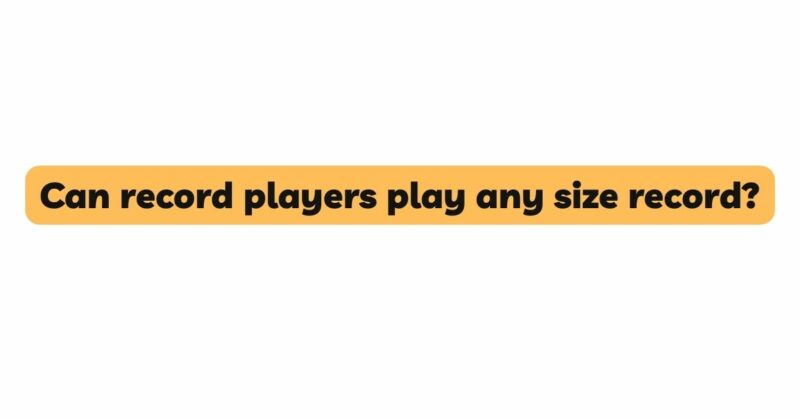The renaissance of vinyl records has brought with it a renewed fascination for analog sound quality and a tactile music experience. In the world of vinyl, questions frequently arise about the compatibility of record players with different sizes of vinyl records. Can record players truly play any size record? This article delves into the intricacies of record player compatibility across various vinyl sizes, shedding light on the factors that influence their adaptability.
A World of Vinyl Sizes
At first glance, it might seem logical that a record player designed to play vinyl records should accommodate any size. However, the reality is more nuanced. Vinyl records come in a range of sizes, each with distinct characteristics and historical contexts. To understand the compatibility conundrum, it’s essential to explore these various vinyl sizes and their implications for record player adaptability.
The Ubiquity of the 12-Inch Record
The 12-inch vinyl record, commonly known as the LP (long-playing) record, is the most recognizable size. With a diameter of 12 inches (30 cm), the LP became the standard format for albums, revolutionizing music distribution upon its introduction in 1948. Its larger surface area allowed for longer playtime and improved audio fidelity, making it the ideal canvas for artists to create cohesive, album-length musical experiences.
The Allure of the 7-Inch Record
Contrasting with the LP, the 7-inch vinyl record, often referred to as the single or the 45, gained popularity for individual song releases. Introduced in 1949, the 7-inch record typically featured a single track on each side and catered to the needs of radio stations and jukeboxes. Its compact size made it a convenient choice for quick playback, contributing to the iconic culture of hit singles.
The 10-Inch Record’s Unique Role
Amidst the dominance of the 12-inch LP and the 7-inch single, the 10-inch vinyl record emerged as a transitional format. Introduced in the late 1940s, the 10-inch record provided an alternative for releasing music that fell between the single and album categories. Often used for EPs (extended plays), the 10-inch format accommodated collections of songs longer than a single but shorter than an album. While less prevalent, the 10-inch format played a vital role in diversifying the vinyl landscape.
Beyond the Standard Sizes
While the 12-inch, 7-inch, and 10-inch formats represent the most common vinyl sizes, there are instances of even smaller and larger formats designed for specific artistic intentions or collectible purposes. These niche sizes, such as 5-inch, 8-inch, and 16-inch records, offer unique listening experiences and cater to collectors who seek rarity and uniqueness.
Compatibility Factors
The notion of record players accommodating any size record introduces a range of compatibility factors that must be considered:
- Platter Size: Record players are designed with specific platter sizes to accommodate the most common vinyl formats. Playing a smaller record on a larger platter can result in tracking issues, sound distortion, and potential damage to the stylus and record.
- Playback Speed: Different vinyl sizes are often associated with different playback speeds, such as 33⅓, 45, and 78 RPM (revolutions per minute). Turntables feature speed settings to match these playback speeds. Playing a record at the incorrect speed alters the pitch and timing of the music.
- Tonearm Length: The tonearm’s length is designed to traverse the grooves of a specific vinyl size accurately. Using a tonearm designed for a larger record to play a smaller record may lead to inaccurate tracking and suboptimal audio quality.
- Cartridge and Stylus: Cartridges and styluses are designed with specific tracking profiles suited to particular groove sizes and shapes. Mismatching cartridges and styluses with different vinyl sizes can result in compromised sound quality and increased wear on both the stylus and the record.
- Adjustability: Some record players offer adjustable tonearms and platter sizes to accommodate different vinyl sizes. However, not all turntables provide this feature, limiting their adaptability to a specific size or set of sizes.
- Mechanical Limitations: Some record players, especially vintage models, may have mechanical limitations that prevent them from properly playing certain vinyl sizes. Modern turntables often offer more versatility in this regard.
Conclusion
While the notion of record players playing any size record seems convenient, the reality is far more complex. Vinyl records come in a range of sizes, each with its own historical significance and playback considerations. The compatibility between record players and vinyl sizes is influenced by factors such as platter size, playback speed, tonearm length, cartridge and stylus compatibility, adjustability, and mechanical limitations.
As the vinyl resurgence continues to captivate audiophiles and music enthusiasts, understanding these compatibility nuances becomes crucial. By delving into the historical evolution of vinyl sizes and the mechanics of record players, enthusiasts can make informed choices about equipment and vinyl acquisitions. Ultimately, this knowledge enhances the appreciation of both the music and the technology that brings it to life, ensuring that the analog experience remains as rich and captivating as ever.


